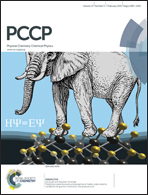Synergistic effects of nonmetal co-doping with sulfur in anatase TiO2: a DFT + U study†
Abstract
Using DFT + U calculations, the crystal structure and electronic properties of nonmetal co-doping with sulfur in anatase TiO2 are systematically investigated. The initial purpose of this work is to improve the photocatalytic performance of S mono-doped TiO2, in which S occupies the lattice Ti site and acts as a recombination center. Among eight nonmetal impurities that occupy the interstitial site of a TiO6 octahedron, the synergistic effects of B, C, and O with S could achieve this purpose: suppressing the recombination of photogenerated electron–hole pairs by inducing a local inner built-in electric field and eliminating the deep impurity energy bands of S mono-doped TiO2. Furthermore, the photon absorption could be extended to the visible-light region, owing to the overlap of impurity energy bands with the top of the valence band or the bottom of the conduction band. Thus, Ti1−xO2SxBy, Ti1−xO2SxCy and Ti1−xO2SxOy could be considered as promising efficient photocatalysts. Furthermore, the underlying mechanism and tendency of these synergistic effects have been discussed, according to the relationship between the photocatalytic performance and the crystal or electronic structure.


 Please wait while we load your content...
Please wait while we load your content...